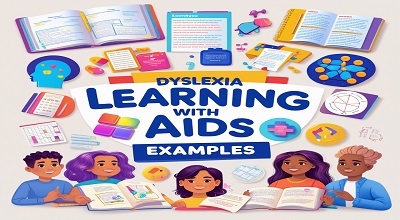Dyslexia Learning Aids
Dyslexia Learning Aids: Dyslexia is a common learning disability that affects reading, writing, and spelling skills. It is neurological in origin and is not linked to intelligence. Individuals with dyslexia often struggle with decoding words, recognizing sounds, and processing written language.
Fortunately, various learning aids and tools have been developed to support dyslexic learners. These aids help improve reading fluency, comprehension, and writing skills. In this article, we explore the latest dyslexia learning aids with real-world examples.
Understanding Dyslexia Learning Challenges
Dyslexia presents differently in each individual, but common challenges include:
- Difficulty in phonological processing (sound recognition)
- Slow reading speed
- Poor spelling and grammar
- Trouble with word retrieval
- Struggles with sequencing and organization
These challenges can impact academic performance, but with the right tools, dyslexic learners can thrive.
Types of Dyslexia Learning Aids
Dyslexia aids can be categorized into:
- Assistive Technology (Text-to-speech, speech-to-text)
- Multisensory Tools (Kinesthetic, visual, auditory)
- Phonics-Based Programs (Structured literacy approaches)
- Visual and Auditory Supports (Colored overlays, audiobooks)
- Reading and Writing Tools (Dyslexia-friendly fonts, spell-checkers)
Assistive Technology for Dyslexia
Examples:
- Text-to-Speech (TTS) Software
- NaturalReader – Converts text into spoken words.
- Kurzweil 3000 – Provides reading and writing support.
- Speech-to-Text (STT) Tools
- Dragon NaturallySpeaking – Allows dictation for writing.
- Google Voice Typing – Free alternative for dictation.
- Electronic Readers
- Amazon Kindle with OpenDyslexic Font – Enhances readability.
Multisensory Learning Approaches
Multisensory techniques engage multiple senses (visual, auditory, kinesthetic) to reinforce learning.
Examples:
- Orton-Gillingham Method – Structured phonics-based teaching.
- Sand Writing – Tracing letters in sand for tactile reinforcement.
- Color-Coding Systems – Using colors to differentiate sounds.
Phonics-Based Dyslexia Aids
Phonics programs help dyslexic learners connect sounds to letters.
Examples:
- Hooked on Phonics – Interactive phonics lessons.
- Wilson Reading System – Structured literacy program.
- Lexia Core5 – Adaptive phonics software.
Visual and Auditory Dyslexia Tools
Examples:
- Colored Overlays – Reduce visual stress (e.g., Irlen Syndrome filters).
- Audiobooks – Learning Ally, Audible for accessible reading.
- Dyslexia-Friendly Fonts – OpenDyslexic, Dyslexie Font.
Reading and Writing Support Tools
Examples:
- Grammarly – Grammar and spell-checker.
- Ginger Software – Contextual spelling correction.
- Read&Write by Texthelp – Comprehensive literacy support.
Apps and Software for Dyslexia
Examples:
- Speechify – Text-to-speech app.
- ClaroRead – Reading and writing assistant.
- ModMath – Helps with dysgraphia (math writing).
Classroom Accommodations for Dyslexic Students
- Extra time on tests
- Use of audiobooks
- Preferential seating
- Note-taking assistance
Latest Research and Innovations in Dyslexia Aids
Recent advancements include:
- AI-powered reading assistants
- Virtual reality (VR) reading environments
- Neurofeedback training
Choosing the Right Dyslexia Aid
Consider:
- The learner’s specific needs
- Ease of use
- Cost and accessibility
Success Stories and Case Studies
- A student improved reading speed using NaturalReader.
- A writer with dyslexia published a book using Dragon NaturallySpeaking.
Conclusion
Dyslexia learning aids have revolutionized education for dyslexic individuals. By leveraging technology and multisensory approaches, learners can overcome challenges and achieve academic success.
FAQs
1. What is the best assistive technology for dyslexia?
Text-to-speech software like NaturalReader and Kurzweil 3000 are highly effective.
2. Can dyslexia be cured?
Dyslexia is lifelong, but with the right tools, individuals can manage it effectively.
3. Are there free dyslexia apps available?
Yes, Google Voice Typing and OpenDyslexic Font are free options.
4. How do colored overlays help dyslexia?
They reduce visual stress and improve reading fluency.
5. What teaching method works best for dyslexia?
The Orton-Gillingham approach is widely recommended.
Download Link: Dragon Ball Z Budokai Tenkaichi 3 APK
